Gifted Characteristics and 2e: An Overview
| Sitio: | Colorado Education Learning Management System |
| Curso: | 2e (Open Access) Supporting Twice Exceptional Learners |
| Libro: | Gifted Characteristics and 2e: An Overview |
| Impreso por: | Invitado |
| Fecha: | sábado, 6 de diciembre de 2025, 01:33 |
Descripción
Gifted May Not Be What You Think
Myths
The U.S. Department of Education's Office of Civil Rights estimates that six (6) percent of public school students are enrolled in gifted and talented programs (National Association for Gifted Children (NAGC), FAQ). A small number of children are gifted "across the board"--showing outstanding ability in multiple areas; the majority, however, display their giftedness in particular areas, perhaps excelling in math but not in language arts or excelling in the arts (music, dance, painting, theatre) and not in academic subjects.
The myth, however, that gifted students are the "good students" and will succeed easily is still alive and well. As one teacher writes:If you want gifted kids to be successful, you must believe that gifted education is exceptional education. Many teachers do extraordinary things to help students with learning disabilities be successful. However, when it comes to students who are gifted, some teachers are inflexible and resentful of the behaviors characteristic of being gifted. Not a week goes by when one of my students’ regular education teachers doesn't give me an earful about my students’ lack of organizational skills, continuous questioning of authority, or underachievement. I do understand their frustrations; however, these behaviors are actually characteristics of gifted children...Simply put, gifted students have exceptional needs with their exceptional gifts. Treating gifted students as exceptional-education students goes a long way towards meeting their needs. In all honesty, simply remembering they are exceptional-education students can make your days with this difficult population more pleasant (Gifted Ed. Students Are More Than Just Really Smart Kids).
In this 6:50 minute video, "Why Gifted May Not Be What You Think," Michelle Barmaze explains why gifted children are special needs children. She briefly mentions two characteristics of most gifted children, asynchronicity and overexcitabilities, and she touches on 2e learners. We hope this video helps inform your "why" and inspires you to see how much these children need your help.
There are myths that continue about gifted students. One is that they are always high achieving and another is that they don't need special attention, that they will do okay on their own; however, there is research that indicates that "40 percent of all gifted students may be underachievers" (Davidson Institute. N.D. Gifted traits and characteristics citing Handbook of Gifted Education, p. 424. Retrieved on April 22, 2022).
Common Characteristics of Gifted Students
Gifted students are unique individuals, so no one gifted student will have all possible gifted traits. Below are some common characteristics of giftedness. Some of these traits may be perceived as negative both by others and by the gifted student. (An accessible copy for the visually impaired, select HERE.)

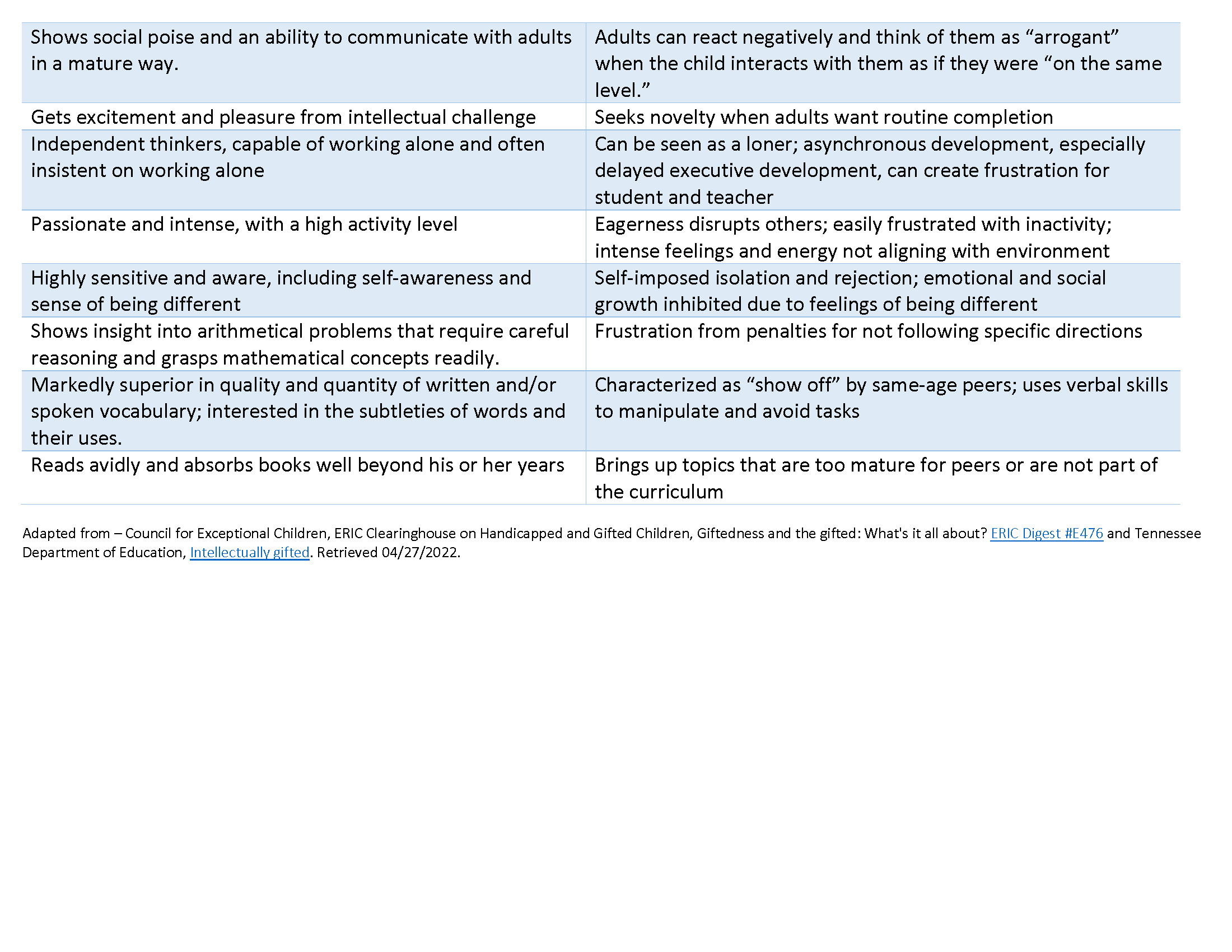
Perfectionism
Although it is somewhat less common among 2e students than other gifted students., approximately 20% of gifted children suffer from perfectionism to the degree it causes problems.
Perfectionism Is Not
Perfectionism is not working hard on something nor even overworking for awhile to get something done on a deadline or out of passion for the work. It is not setting high personal standards or striving toward excellence. A difference between healthy striving and perfectionism is healthy strivers do the best they can with the time and tools they have yet have effective coping strategies for accepting mistakes, the inevitable less-than-perfect output and even the failures that will occur.
Dysfunctional Perfectionism Is
- Having a compulsive drive to achieve, where personal value is based on what is produced or accomplished
- Having unrealistic standards for self and unreasonable goals
- Having high, even paralyzing, anxiety about making mistakes
- Feeling guilty if not engaged in meaningful work at all
times
- Feeling continually dissatisfied about one's work--which can lead to depression, anxiety and other physical symptoms
- Questioning own judgment and having a high need for approval
- Procrastinating to the extreme out of fear of failure
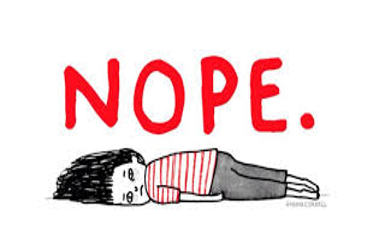
When perfectionism becomes pervasive and compulsive, it leaves no room for error. It provides little satisfaction and much self-criticism because the results never feel good enough. Perfectionism becomes unhealthy when it causes stress, pain, illness, procrastination and underachievement.
A perfectionist will often feel shame, guilt, depression and have the need to "save face." They will often resort to one or more behaviors to help them hide their fear of being imperfect: 1) not starting a project, 2) not handing in a finished project, or 3) starting so many projects that there isn't time to complete any of them.
Strategies to Support Students with Unhealthy Perfectionism
(credit: Greenspon, 2007)
1) Dive In
Just start, you can always go back later and make changes. After you once dive in, try it again with something else you are putting off. The more times you dive in the easier it will become.
2) Not "right," just "write"
Write about your thoughts and feelings. See things you are getting better at, something you did well, make a list of things that help you relax and worry less.
3) Crack Up
Use humor, when you are feeling stress find something to laugh at. Laughter releases endorphins and makes your body feel better.
4) Move it
Move. Perfectionism puts a lot of stress on your body. Exercise is a healthy way to burn off stress.
5) Imagine someone else did it
Imagine if someone else did what you did. What would you say to your best friend if they did this? Would you think she is not good enough? Probably not, so be easier on yourself.
6) Just say no
Don’t take on so many tasks; practice saying no in many different ways like, “Sorry, but I’m busy right now, but thanks for asking!”
7) Do something that can't be judged
Try something that you aren’t judged on; something just for fun - even as simple as taking a walk or reading a book...
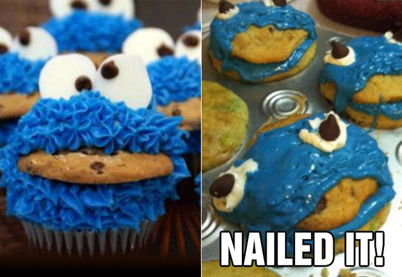
Optional:
To read Sylvia Rimm, a noted expert on perfectionism, (or to bookmark the site for future reading) - Click here.
To read about perfectionism from the National Association for Gifted Children - Click here.
Understanding Twice-Exceptionality
Colorado Twice-Exceptional Definition
According to the Colorado Department of Education, twice-exceptional students are those who are identified as gifted according to state criteria
AND
Identified with a disability according to federal/state criteria - and the disability qualifies the student for either an Individual Education Plan (IEP) or a Section 504 Plan.
Not all disabilities require that the student have one of these plans. Twice-exceptional students are those who are identified as gifted and who qualify for an IEP or a 504 plan.
(Optional: For a list of the categories in which a student can be identified as gifted in Colorado, see HERE. For a list of disability categories, visit the Special Education webpage with the disabilities listed and more information about each one. )
Beginning to Understand 2e Students
Beginning to Understand 2e Students
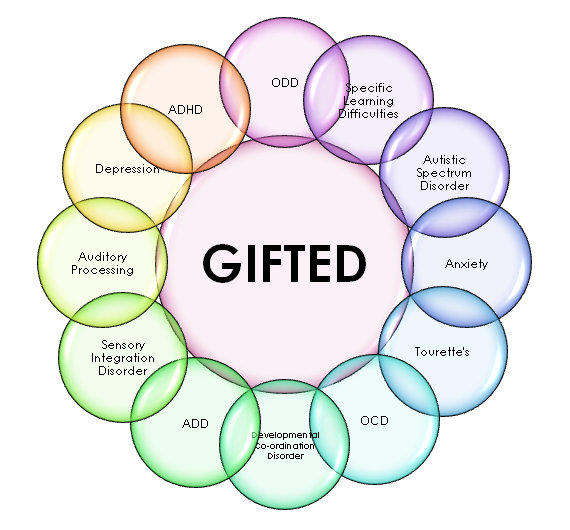
"The term 2e [twice-exceptional] is utilized to describe students who have both gifts/talents and disabilities. Over three decades of scholarship has indicated that the needs of this group overlap and yet are distinct from both individuals who are gifted and individuals with disabilities" (Reis, S.M., Gelbar, N.W. & Madaus, J.W. , 2021).*
Twice-exceptional children generally have little difficulty grasping concepts or generating ideas. If they have a physical disability, such as visual impairment, we automatically understand that supports must be provided for them to access the curriculum, but when they falter in getting their ideas down on paper, writing legibly, doing calculations accurately, staying organized, following instructions or decoding text, they are often accused of being distracted, uninterested, disruptive or lazy. It is easy to think they could improve by just trying harder, but usually they are trying harder than most students--until they give up.
According to Micaela Bracamonte
Researchers have worked to shed light on the pattern of abilities and relative deficits displayed by 2e students in order to simplify their identification by teachers and administrators. These students are a diverse group with a wide variety of gifts and talents in combination with various learning challenges that often resist categorization. There is, in fact, no single defining pattern of characteristics or test scores. Credit: 2e Newsletter
- An outstanding talent or ability
- A learning challenge--which might be physical, cognitive, or affective
- A discrepancy between potential and actual achievement - without support for their learning challenge(s)
* Reis, S.M., Gelbar, N.W. & Madaus, J.W. (2021). Understanding the academic success of academically talented college students with autism spectrum disorders. J Autism Dev Disord.
Neuroeducation
Building Blocks of Brain Development
(Credit for this
chapter: Hotchkiss, 2017, link below)
Heather Hotchkiss, CDE, and the Colorado Brain Injury Steering Committee have created a framework originally intended to support students with brain injury, but this brain-based framework is a user-friendly model that helps us understand why a gifted student with a disability can be underachieving and how to help support them. The framework has three parts: a set of building blocks that helps us specifically understand how students are functioning, a set of assessments aligned with each building block that can be done in the school setting, and a set of strategies to address deficits for each brain process. Hotchkiss cautions that while there is not an agreed upon model to represent the brain; the one presented here was created to help school teams collect data to complete a thorough neuroeducation evaluation for special education eligibility. The model helps us understand the common areas that are affected when development is disrupted.
Development of the processes in one row are dependent on the development of the processes in the rows below them. In other words, achievement (top row) is dependent on each row below it. The building blocks in the bottom row are foundational to all learning and behavior and are the most sensitive to disruption. As you can see in the diagram, these fundamental processes are memory, processing speed, attention, inhibition and sensory-motor processes. Language forms the next layer of processes, then higher order processes such as executive functioning and finally achievement is at the top. (For the visually impaired, you can access an audio version of this information on the building blocks of brain development
Due to the integrative nature of our brains, just one building block that is not functioning well can affect all the other processes. For example, as depicted below, if there is a deficit in attention, such as with ADHD, language development can be affected, then higher order skills such as executive function, and finally achievement is affected. This cascade effect is true for a deficit in any process represented in this model.
The 2nd tool in this framework includes school-based assessments for each of these building blocks. The model below shows commonly used assessments. These assessments are just suggestions and space limitations necessitate only showing one assessment per building block. For more assessments go to Colorado Kids with Brain Injury (optional). CDE does not endorse assessments, and assessments are always changing.
The 3rd tool in this framework has suggested strategies, interventions and/or accommodations for each building block. Again, in the diagram presented below, space limitations necessitate that only a single strategy is represented.
Optional: To find more strategies and to go deeper into the 3 tools of this framework on building blocks for brain development, there is a manual on CDE’s website that defines each building block, how an injury (or deficit) in each building block can affect learning and offers extensive strategies/interventions/accommodations. It is located at CDE or can be downloaded HERE.
Paradoxical Characteristics of 2e Learners
What might trigger you to suspect a student is twice-exceptional? Well, if puzzles or paradoxes come to mind, that is a clue. Does your student have a mix of characteristics from both sides of the table?
(For participants with a visual impairment, an accessible format of the information can be found HERE.)
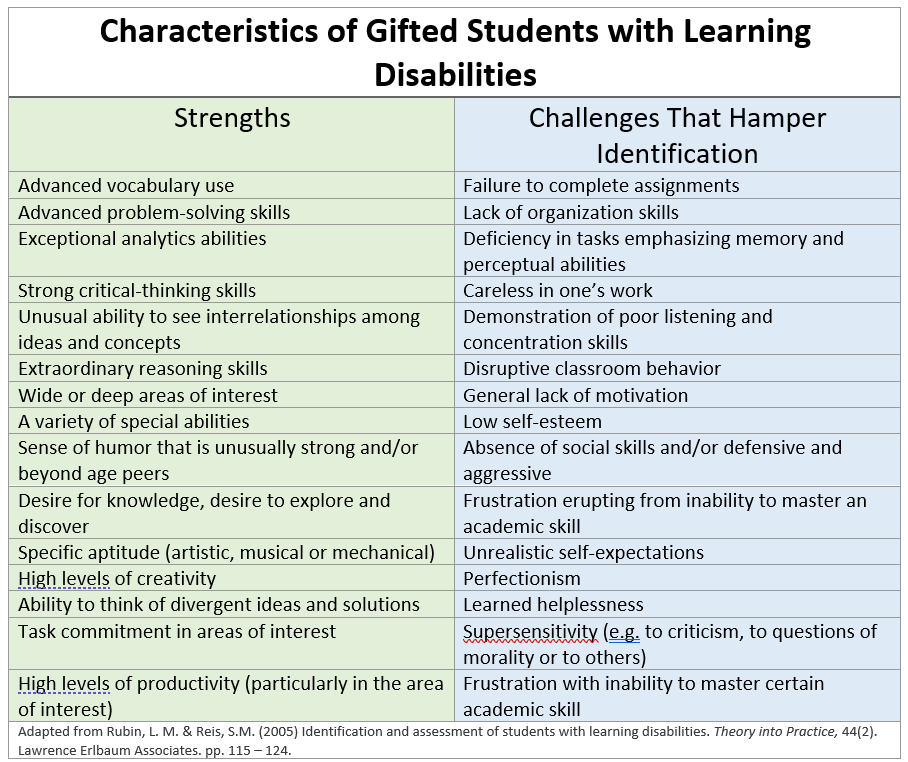
2e and Underrepresented Populations
It is important to emphasize again that not everyone recognizes giftedness in students who do not fit the traditional myth of the well-behaved "A" student. Historically underserved students--students in poverty, of color, with disabilities, and whose first language is not English, are underrepresented in gifted education. In addition, students of color are over-represented in special education. Add in a disability along with being in a marginalized population and we can have this situation:
Students with disabilities are at a higher risk for school discipline than other students, with African American/Black and Latino(a) students with disabilities at an even higher risk. Although there is limited research focusing on the experiences of students of color with disabilities, a 2015 U.S. Commission on Civil Rights report showed that black students with disabilities are almost four times more likely to have multiple suspensions and are twice as likely to be expelled compared to white students with disabilities (Laird, 2019). These exclusionary practices take time away from the classroom which can lead to students with disabilities missing important instructional time, repeating a grade, and/or dropping out of school (Laird, 2019; Southern Disability Law Center, 2014) Credit: Developing Culturally Responsive Resources to Support Advocacy for People with Intellectual and Developmental Disabilities.
If we are more aware of what to look for in all students, we can become better at appropriate identification. Take a few minutes to look over this often-used table developed by E. Nielsen in Albuquerque Public Schools Gifted Task Force (1999). This table is also in the shared Google folder.
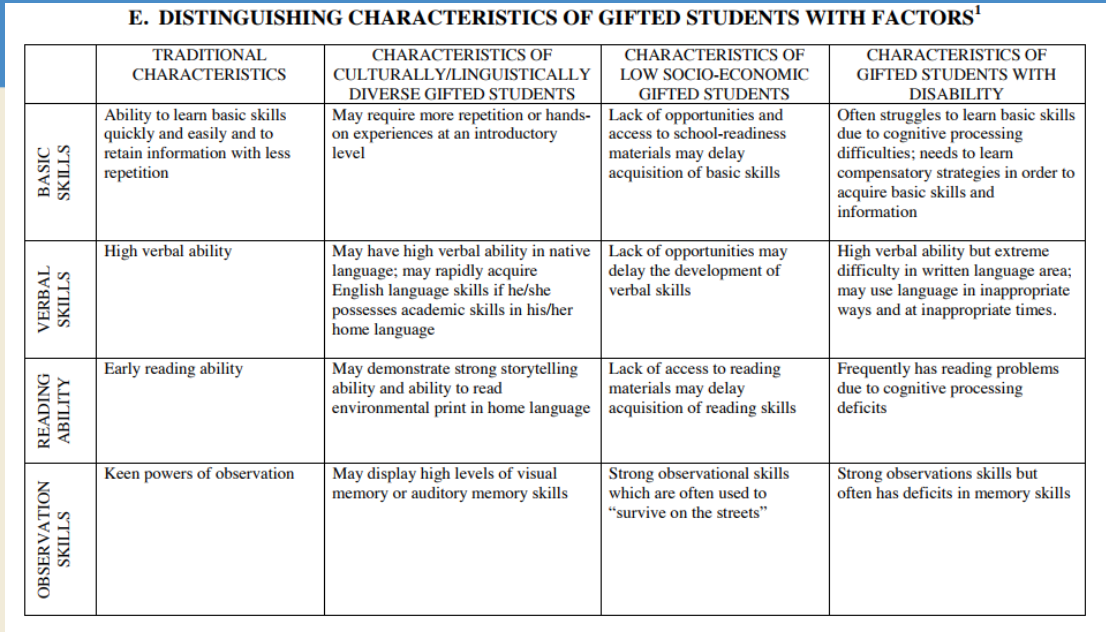
Just like every person, all populations also bring unique strengths to their learning environments. We must be careful not to only look at supposed deficits. For example, English language learners aren't yet proficient in English, but look at the wealth of strengths they bring to your school!
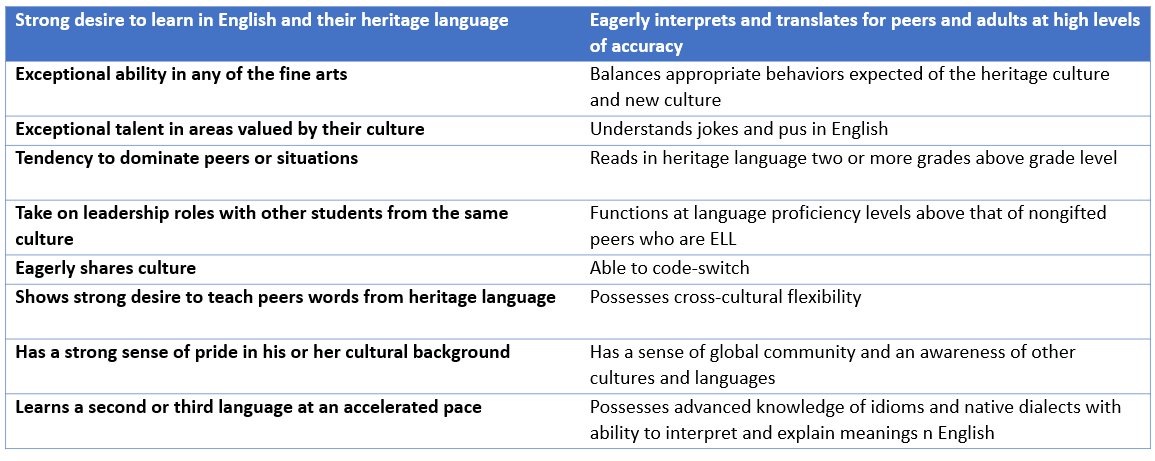
Adapted from Aguirre and Hernandez(1999) and Winebrenner and
Brulles (2008)
The more we understand these complex students the better we can become at noticing their strengths, their needs and how to program for them to ensure they are making growth in their area(s) of strength. While focused on gifted and marginalized, not specifically 2e, THE G WORD has some excellent videos that "reveals the economic, cultural, and gender diversity of our nation’s gifted and talented population at every stage of life, highlighting their educational challenges, social isolation, deep emotional sensitivities, and complex, neurodiverse brains" (The G Word). Take a moment to glance at it and see if you would like to bookmark it for future use.
For a Deeper Dive (optional)
We need to consider the assessments we use to achieve equity in gifted education.
Adams 12 has kindly offered to share their document "Profiles of the Gifted & Talented – Matrix" which contrasts verbal, non-verbal, quantitative, creative and cultural characteristics of gifted students who are English language learners, in poverty or twice-exceptional. They also suggest some possible instruments to collect data for each population. Below is a sample of the document. To access and download the full document, click HERE.

Access Resources in Shared Folder
Take this chance to go to the Shared Google Folder and find more information about gifted characteristics, including George Betts "Profiles of Gifted Learners," overexcitabilities, more on asynchronous development, and the entire first chapter of Twice-Exceptional Children: Understanding, Teaching, and Counseling Gifted Students by Beverly Trail. You might want to bookmark the folder for later use and check for updates.
If you have used resources to help identify or support 2e learners that you think we should share with others, please share them with Dr. Cynthia Rundquist so that she can put them in the folder, rundquist_c@cde.state.co.us.